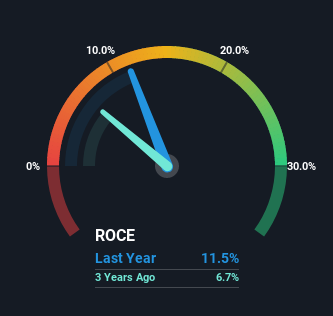
What trends should we look for it we want to identify stocks that can multiply in value over the long term? Firstly, we'd want to identify a growing return on capital employed (ROCE) and then alongside that, an ever-increasing base of capital employed. Basically this means that a company has profitable initiatives that it can continue to reinvest in, which is a trait of a compounding machine. So when we looked at ATI (NYSE:ATI) and its trend of ROCE, we really liked what we saw.
Return On Capital Employed (ROCE): What Is It?
For those that aren't sure what ROCE is, it measures the amount of pre-tax profits a company can generate from the capital employed in its business. The formula for this calculation on ATI is:
Return on Capital Employed = Earnings Before Interest and Tax (EBIT) ÷ (Total Assets - Current Liabilities)
0.12 = US$399m ÷ (US$4.3b - US$824m) (Based on the trailing twelve months to March 2023).
Thus, ATI has an ROCE of 12%. That's a relatively normal return on capital, and it's around the 13% generated by the Metals and Mining industry.
See our latest analysis for ATI

In the above chart we have measured ATI's prior ROCE against its prior performance, but the future is arguably more important. If you'd like to see what analysts are forecasting going forward, you should check out our free report for ATI.
SWOT Analysis for ATI
- Earnings growth over the past year exceeded the industry.
- Debt is well covered by earnings.
- Shareholders have been diluted in the past year.
- Annual earnings are forecast to grow faster than the American market.
- Good value based on P/E ratio and estimated fair value.
- Debt is not well covered by operating cash flow.
- Annual revenue is forecast to grow slower than the American market.
What Does the ROCE Trend For ATI Tell Us?
You'd find it hard not to be impressed with the ROCE trend at ATI. The figures show that over the last five years, returns on capital have grown by 146%. The company is now earning US$0.1 per dollar of capital employed. Speaking of capital employed, the company is actually utilizing 25% less than it was five years ago, which can be indicative of a business that's improving its efficiency. ATI may be selling some assets so it's worth investigating if the business has plans for future investments to increase returns further still.
What We Can Learn From ATI's ROCE
From what we've seen above, ATI has managed to increase it's returns on capital all the while reducing it's capital base. Considering the stock has delivered 31% to its stockholders over the last five years, it may be fair to think that investors aren't fully aware of the promising trends yet. So with that in mind, we think the stock deserves further research.
On a final note, we found 3 warning signs for ATI (1 is concerning) you should be aware of.
While ATI may not currently earn the highest returns, we've compiled a list of companies that currently earn more than 25% return on equity. Check out this free list here.
New: Manage All Your Stock Portfolios in One Place
We've created the ultimate portfolio companion for stock investors, and it's free.
• Connect an unlimited number of Portfolios and see your total in one currency
• Be alerted to new Warning Signs or Risks via email or mobile
• Track the Fair Value of your stocks
Have feedback on this article? Concerned about the content? Get in touch with us directly. Alternatively, email editorial-team (at) simplywallst.com.
This article by Simply Wall St is general in nature. We provide commentary based on historical data and analyst forecasts only using an unbiased methodology and our articles are not intended to be financial advice. It does not constitute a recommendation to buy or sell any stock, and does not take account of your objectives, or your financial situation. We aim to bring you long-term focused analysis driven by fundamental data. Note that our analysis may not factor in the latest price-sensitive company announcements or qualitative material. Simply Wall St has no position in any stocks mentioned.
About NYSE:ATI
ATI
Produces and sells specialty materials and complex components worldwide.
Good value with adequate balance sheet.
Similar Companies
Market Insights
Community Narratives



